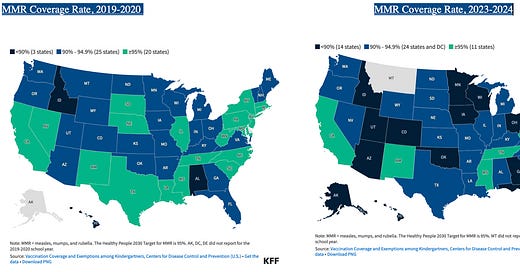New Report: Vaccination Rates for Kindergarteners Drop Across the Nation
Montana is the only state that has not reported for 2023-2024 school year
By Denise Rivette
KFF issued a policy watch providing an update on the latest trends in children’s routine vaccination and exemption rates. It finds that vaccination rates continue to decline and exemptions continue to increase, following a trend that began with the pandemic. While states and local jurisdictions, not the federal government, set vaccine requirements for school children, the federal government has a long-standing, evidence-based system for approving and recommending vaccines for the public, including the childhood vaccination schedule, which is used by states, pediatricians, and parents.
Regarding kindergarteners, KFF reported the following:
The share of kindergarten children up to date on their vaccinations continues to decline. Data collected and aggregated annually by the CDC from state and local immunization programs found that less than 93% of kindergarteners had been vaccinated with all state required vaccines, including MMR, DTaP (diphtheria, tetanus, and acellular pertussis), polio, and varicella in the 2023-2024 school year, down from 95% in the 2019-2020 (pre-pandemic) school year, and below coverage levels of the past decade. In all four school years since the pandemic began, the MMR vaccination rate has fallen below the Healthy People 2030 “target” rate of 95%, the level needed to prevent community transmission of measles, a highly contagious and life-threatening virus. This means approximately 280,000 school children were unvaccinated and unprotected against measles, and research shows the more unvaccinated children in a school, the larger risk of an outbreak becomes. While noting that widespread measles transmission risk remains low, the CDC reported as of November 7, 2024 that there have been 16 measles outbreaks in 2024 compared with four outbreaks in 2023.
Over three-quarters (39) of states had MMR vaccination rates below the “target” rate of 95% for the 2023-2024 school year, an increase from 28 states during the 2019-2020 (pre-pandemic) school year (see below). Further, 14 states reported rates below 90% for the 2023-2024 school year, compared to only three states in the 2019-2020 school year. In the last year alone, over 30 states experienced declines in vaccination rates across all state required vaccines, including MMR, DTaP, polio, and varicella. There is also substantial variation in vaccination rates across states, with MMR coverage rates among kindergarteners for the latest school year ranged from a low of 79.6% in Idaho to a high of 98.3% in West Virginia. There can also be variation in vaccination coverage within states, and, when there are clusters of unvaccinated people within a specific community, the risk of an outbreak is higher.
Fourteen states had more than 5% of kindergarteners claiming a vaccine exemption during the 2023-2024 school year. Those states could not reach vaccination coverage rates at or above 95% even if all non-exempt children were vaccinated (rates discussed here are for exemptions to one or more vaccines, so potentially achievable coverage rates could vary by vaccine type). In the last year alone, over three quarters of states (41) have experienced an increase in the share of kindergarteners claiming an exemption for one or more vaccines.
In the 2019-2020 school year Montana reported an MMR vaccination rate for kindergarteners of 90% - 94.9% and an exemption rate of 3% - 4.9%. Montana is the only state that did not report for the 2023-2024 school year.
Requests via email and phone to the Carbon County Public Health Department for the vaccination rates of Carbon County remain unanswered.





Will be interesting to see how parents react when their kids die of the easily preventable diseases that are making a comeback due to fewer kids getting vaccinated.